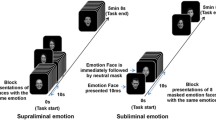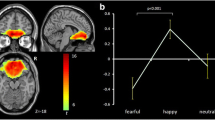Abstract
Objective
Erythropoietin (Epo) has neuroprotective and neurotrophic effects, and may be a novel therapeutic agent in the treatment of psychiatric disorders. We have demonstrated antidepressant-like effects of Epo on the neural and cognitive processing of facial expressions in healthy volunteers. The current study investigates the effects of Epo on the neural and cognitive response to emotional facial expressions in depressed patients.
Method
Nineteen acutely depressed patients were randomized to receive Epo (40,000 IU) or saline intravenously in a double-blind, parallel-group design. On day 3, we assessed neuronal responses to fearful and happy faces using functional magnetic resonance imaging and measured facial expression recognition after the scan.
Results
Epo reduced neural response to fearful vs. happy faces in the amygdala and hippocampus, and to fearful faces vs. baseline in superior temporal and occipitoparietal regions 3 days after administration in acutely depressed patients. This was accompanied by a specific reduction in the recognition of fear in Epo-treated patients after the scan similar to the effects on face recognition seen with antidepressant drug treatment.
Conclusions
The present findings are similar to the effects of conventional antidepressants in acutely depressed patients and opposite to hypervigilance to negative facial expressions in depression. This highlights a potential antidepressant mechanism and warrants further investigation of Epo as a new candidate compound for treatment of depression.



Similar content being viewed by others
References
Adamcio B, Sargin D, Stradomska A, Medrihan L, Gertler C, Theis F, Zhang MY, Muller M, Hassouna I, Hannke K, Sperling S, Radyushkin K, El-Kordi A, Schulze L, Ronnenberg A, Wolf F, Brose N, Rhee JS, Zhang WQ, Ehrenreich H (2008) Erythropoietin enhances hippocampal long-term potentiation and memory. Bmc Biol 6:37
Agnello D, Bigini P, Villa P, Mennini T, Cerami A, Brines ML, Ghezzi P (2002) Erythropoietin exerts an anti-inflammatory effect on the CNS in a model of experimental autoimmune encephalomyelitis. Brain Res 952:128–134
Alcalá-Barraza SR, Lee MS, Hanson LR, McDonald A, Frey WH, McLoon LK (2009) Intranasal delivery of neurotrophic factors BDNF, CNTF, EPO, and NT-4 to the CNS. J Drug Target 18:179–190
Austin MP, Ross M, Murray C, Ocarroll RE, Ebmeier KP, Goodwin GM (1992) Cognitive function in major depression. J Affect Disord 25:21–29
Beck AT, Erbaugh J, Ward CH, Mock J, Mendelsohn M (1961) An inventory for measuring depression. Arch Gen Psychiatry 4:561–571
Belmaker RH, Agam G (2008) Mechanisms of disease: major depressive disorder. N Engl J Med 358:55–68
Berton O, Nestler EJ (2006) New approaches to antidepressant drug discovery: beyond monoamines. Nat Rev Neurosci 7:137–151
Bhagwagar Z, Cowen PJ, Goodwin GM, Harmer CJ (2004) Normalization of enhanced fear recognition by acute SSRI treatment in subjects with a previous history of depression. Am J Psychiatry 161:166–168
Bouhuys AL, Geerts E, Gordijn MC (1999) Depressed patients' perceptions of facial emotions in depressed and remitted states are associated with relapse: a longitudinal study. J Nerv Ment Dis 187:595–602
Boynton GM, Engel SA, Glover GH, Heeger DJ (1996) Linear systems analysis of functional magnetic resonance imaging in human V1. J Neurosci 16:4207–4221
Bradley BP, Mogg K, Williams R (1995) Implicit and explicit memory for emotion-congruent information in clinical depression and anxiety. Behav Res Ther 33:755–770
Brines M, Cerami A (2005) Emerging biological roles for erythropoietin in the nervous system. Nat Rev Neurosci 6:484–494
Brines ML, Ghezzi P, Keenan S, Agnello D, de Lanerolle NC, Cerami C, Itri LM, Cerami A (2000) Erythropoietin crosses the blood-brain barrier to protect against experimental brain injury. Proc Natl Acad Sci U S A 97:10526–10531
Chen ZY, Asavaritikrai P, Prchal JT, Noguchi CT (2007) Endogenous erythropoietin signaling is required for normal neural progenitor cell proliferation. J Biol Chem 282:25875–25883
DeRubeis RJ, Siegle GJ, Hollon SD (2008) Opinion—cognitive therapy versus medication for depression: treatment outcomes and neural mechanisms. Nat Rev Neurosci 9:788–796
Desmond JE, Glover GH (2002) Estimating sample size in functional MRI (fMRI) neuroimaging studies: statistical power analyses. J Neurosci Methods 118:115–128
Ehrenreich H, Hinze-Selch D, Stawicki S, Aust C, Knolle-Veentjer S, Wilms S, Heinz G, Erdag S, Jahn H, Degner D, Ritzen M, Mohr A, Wagner M, Schneider U, Bohn M, Huber M, Czernik A, Pollmacher T, Maier W, Siren AL, Klosterkotter J, Falkai P, Ruther E, Aldenhoff JB, Krampe H (2007a) Improvement of cognitive functions in chronic schizophrenic patients by recombinant human erythropoietin. Mol Psychiatry 12:206–220
Ehrenreich H, Fischer B, Norra C, Schellenberger F, Stender N, Stiefel M, Siren AL, Paulus W, Nave KA, Gold R, Bartels C (2007b) Exploring recombinant human erythropoietin in chronic progressive multiple sclerosis. Brain 130:2577–2588
Ekman P, Friesen WV (1976) Pictures of facial affect. Consulting Psychologists Press, Palo Alto
Ferrario E, Ferrari L, Bidoli P, De CD, Del VM, De DS, Buzzoni R, Bajetta E (2004) Treatment of cancer-related anemia with epoetin alfa: a review. Cancer Treat Rev 30:563–575
Fu CH, Williams SC, Cleare AJ, Brammer MJ, Walsh ND, Kim J, Andrew CM, Pich EM, Williams PM, Reed LJ, Mitterschiffthaler MT, Suckling J, Bullmore ET (2004) Attenuation of the neural response to sad faces in major depression by antidepressant treatment: a prospective, event-related functional magnetic resonance imaging study. Arch Gen Psychiatry 61:877–889
Fu CHY, Williams SCR, Brammer MJ, Suckling J, Kim J, Cleare AJ, Walsh ND, Mitterschiffthaler MT, Andrew CM, Pich EM, Bullmore ET (2007) Neural responses to happy facial expressions in major depression following antidepressant treatment. Am J Psychiatry 164:599–607
Giacobbe P, Mayberg HS, Lozano AM (2009) Treatment resistant depression as a failure of brain homeostatic mechanisms: implications for deep brain stimulation. Exp Neurol 219:44–52
Gur RC, Erwin RJ, Gur RE, Zwil AS, Heimberg C, Kraemer HC (1992) Facial emotion discrimination: II. Behavioral findings in depression. Psychiatry Res 42:241–251
Hamilton M (1960) A rating scale for depression. J Neurol Neurosurg Psychiatry 23:56–62
Hamilton JP, Gotlib IH (2008) Neural substrates of increased memory sensitivity for negative stimuli in major depression. Biol Psychiatry 63:1155–1162
Hammar A, Lund A, Hugdahl K (2003) Long-lasting cognitive impairment in unipolar major depression: a 6-month follow-up study. Psychiatry Res 118:189–196
Harmer CJ, Bhagwagar Z, Perrett DI, Vollm BA, Cowen PJ, Goodwin GM (2003) Acute SSRI administration affects the processing of social cues in healthy volunteers. Neuropsychopharmacology 28:148–152
Harmer CJ, Shelley NC, Cowen PJ, Goodwin GM (2004) Increased positive versus negative affective perception and memory in healthy volunteers following selective serotonin and norepinephrine reuptake inhibition. Am J Psychiatry 161:1256–1263
Harmer CJ, Mackay CE, Reid CB, Cowen PJ, Goodwin GM (2006) Antidepressant drug treatment modifies the neural processing of nonconscious threat cues. Biol Psychiatry 59:816–820
Harmer CJ, O'Sullivan U, Favaron E, Massey-Chase R, Ayres R, Reinecke A, Goodwin GM, Cowen PJ (2009a) Effect of acute antidepressant administration on negative affective bias in depressed patients. Am J Psychiatry 166:1178–1184
Harmer CJ, Goodwin GM, Cowen PJ (2009b) Why do antidepressants take so long to work? A cognitive neuropsychological model of antidepressant drug action. Br J Psychiatry 195:102–108
Kessing LV (1998) Cognitive impairment in the euthymic phase of affective disorder. Psychol Med 28:1027–1038
Lancaster JL, Woldorff MG, Parsons LM, Liotti M, Freitas ES, Rainey L, Kochunov PV, Nickerson D, Mikiten SA, Fox PT (2000) Automated Talairach Atlas labels for functional brain mapping. Hum Brain Mapp 10:120–131
Lawrence NS, Williams AM, Surguladze S, Giampietro V, Brammer MJ, Andrew C, Frangou S, Ecker C, Phillips ML (2004) Subcortical and ventral prefrontal cortical neural responses to facial expressions distinguish patients with bipolar disorder and major depression. Biol Psychiatry 55:578–587
Loeber RT, Gruber SA, Cohen BM, Renshaw PF, Sherwood AR, Yurgelun-Todd DA (2002) Cerebellar blood volume in bipolar patients correlates with medication. Biol Psychiatry 51:370–376
Maldjian JA, Laurienti PJ, Kraft RA, Burdette JH (2003) An automated method for neuroanatomic and cytoarchitectonic atlas-based interrogation of fMRI data sets. Neuroimage 19:1233–1239
Manji HK, Moore GJ, Rajkowska G, Chen G (2000) Neuroplasticity and cellular resilience in mood disorders. Mol Psychiatry 5:578–593
Marcos T, Salamero M, Gutierrez F, Catalan R, Gasto C, Lazaro L (1994) Cognitive dysfunctions in recovered melancholic patients. J Affect Disord 32:133–137
Miskowiak K, O'Sullivan U, Harmer CJ (2007) Erythropoietin reduces neural and cognitive processing of fear in human models of antidepressant drug action. Biol Psychiatry 62:1244–1250
Miskowiak K, Inkster B, Selvaraj S, Wise R, Goodwin GM, Harmer CJ (2008) Erythropoietin improves mood and modulates the cognitive and neural processing of emotion 3 days post administration. Neuropsychopharmacology 33:611–618
Miskowiak KW, Favaron E, Hafizi S, Inkster B, Goodwin GM, Cowen PJ, Harmer CJ (2009) Effects of erythropoietin on emotional processing biases in patients with major depression: an exploratory fMRI study. Psychopharmacology (Berl) 207:133–142
Norbury R, Selvaraj S, Taylor MJ, Harmer C, Cowen PJ (2009) Increased neural response to fear in patients recovered from depression: a 3 T functional magnetic resonance imaging study. Psychol Med 40:425–432
Rauch SL, Shin LM, Wright CI (2003) Neuroimaging studies of amygdala function in anxiety disorders. Ann N Y Acad Sci 985:389–410
Sheline YI, Barch DM, Donnelly JM, Ollinger JM, Snyder AZ, Mintun MA (2001) Increased amygdala response to masked emotional faces in depressed subjects resolves with antidepressant treatment: an fMRI study. Biol Psychiatry 50:651–658
Snaith RP, Zigmond AS (1986) The hospital anxiety and depression scale. Br Med J 292:344
Snaith RP, Baugh SJ, Clayden AD, Husain A, Sipple MA (1982) The clinical anxiety scale: an instrument derived from the Hamilton Anxiety Scale. Br J Psychiatry 141:518–523
Snyder M, Cantor N (1980) Thinking about ourselves and others-self-monitoring and social knowledge. J Pers Soc Psychol 39:222–234
Talairach J, Tournoux P (1988) Co-planar stereotaxic atlas of the human brain. Thieme, New York
Viviani B, Bartesaghi S, Corsini E, Villa P, Ghezzi P, Garau A, Galli CL, Marinovich M (2005) Erythropoietin protects primary hippocampal neurons increasing the expression of brain-derived neurotrophic factor. J Neurochem 93:412–421
Vuilleumier P (2005) How brains beware: neural mechanisms of emotional attention. Trends Cogn Sci 9:585–594
Vuilleumier P, Pourtois G (2007) Distributed and interactive brain mechanisms during emotion face perception: evidence from functional neuroimaging. Neuropsychologia 45:174–194
Williams JMG, Watts FN, MacLeod C, Mathews A (1997) Cognitive psychology and emotional disorders. Wiley, Chichester
Woolrich MW, Ripley BD, Brady M, Smith SM (2001) Temporal autocorrelation in univariate linear modeling of FMRI data. Neuroimage 14:1370–1386
Woolrich MW, Behrens TEJ, Beckmann CF, Jenkinson M, Smith SM (2004) Multilevel linear modelling for FMRI group analysis using Bayesian inference. Neuroimage 21:1732–1747
Acknowledgements
This study was supported by the Lundbeck Foundation, Denmark (grant no. 94/04).
Disclosures
Drs. Miskowiak, Favaron, Hafizi, and Inkster report no competing interests. Dr. Miskowiak has received grant support from the Economic and Social Research Council, University of Oxford, and the Lundbeck Foundation, Denmark. Dr. Inkster is funded by Imperial College, London. Professor Goodwin has received honoraria from AstraZeneca, BMS, Eisai, Lundbeck, Sanofi-Aventis, and Servier; has acted as advisor for AstraZeneca, BMS, Lilly, Lundbeck, P1Vital, Sanofi-Aventis, Servier, and Wyeth; holds share options in P1vital; and has acted as an expert witness for Eli Lilly. Professor Goodwin has also received grants from Bailly Thomas Fund, MRC, and Stanley MRI. Professsor Cowen has served as a paid member of advisory boards for DSM, Eli Lilly, Sevier, Wyeth, and Xytis. Dr. Harmer has received grant support from the Medical Research Council, University of Oxford, Merck, Sharpe, and Dohme; has acted as a consultant for Lundbeck, Merck, Sharpe, Dohme, Servier, GSK, and P1Vital; and also holds shares in P1vital.
Author information
Authors and Affiliations
Corresponding author
Rights and permissions
About this article
Cite this article
Miskowiak, K.W., Favaron, E., Hafizi, S. et al. Erythropoietin modulates neural and cognitive processing of emotional information in biomarker models of antidepressant drug action in depressed patients. Psychopharmacology 210, 419–428 (2010). https://doi.org/10.1007/s00213-010-1842-7
Received:
Accepted:
Published:
Issue Date:
DOI: https://doi.org/10.1007/s00213-010-1842-7




